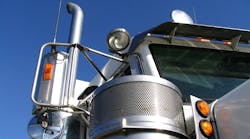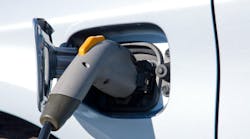ClearFlame Engine Technologies, an Illinois-based company working toward decarbonization for the heavy-duty freight industry, published an independent study that finds its technology could help fleet owners and other heavy-duty truck operators lower their total costs while meeting sustainability goals sooner than currently available alternatives.
The study, conducted by clean transportation consultant Gladstein, Neandross & Associates (GNA) and commissioned by Geneva, Illinois-based ClearFlame itself, analyzed the total cost of ownership (TCO) and the expected emission performance of the company’s engine modification technology in the over-the-road heavy truck market vs. other options, according to a release from ClearFlame.
See also: ATRI study offers warnings on electric Class 8s
The study found that ClearFlame-enabled trucks are expected to have the lowest TCO when compared with diesel, natural gas, electric, and hydrogen platforms; that ClearFlame cost per mile is expected to be substantially lower than electric and hydrogen platforms—40% less than electric and 30% less than hydrogen; and that ClearFlame is estimated to provide a 42% lifecycle carbon reduction compared with diesel trucks as well as about 22% lower greenhouse gases than battery-electric vehicles.
The report also highlights the potential for even greater GHG reductions using other feed sources developed by the ethanol industry with lower carbon intensities. For example, further improvement to ethanol production processes—such as utilizing more corn fiber and stover or adding carbon capture to production facilities—would result in GHG emissions reductions of 69% to 83% compared with diesel, depending on the region.
Finally, the report also finds that while electric and hydrogen platforms have the potential to provide zero tailpipe emissions, these technologies are far from being commercially available for long-haul trucking, and fueling and charging infrastructure remains a significant barrier, as do the costs per mile. As a result, technologies like ClearFlame are one of the only options to provide cost-effective GHG and tailpipe emissions reductions for fleets. ClearFlame is on track to conduct on-road testing with select fleet partners beginning in the second quarter of this year.
See also: Southeast carrier gathering real-world Class 8 EV data
“This study clearly shows that ClearFlame’s technology can provide significant and cost-effective GHG and tailpipe emissions reductions in the immediate future,” said the author of the study, Patrick Couch of Gladstein, Neandross & Associates. “While most of the discussion around sustainable fuels today focuses on compressed natural gas, battery-electric, and hydrogen fuel cell vehicles, alcohol fuels have the potential to play a valuable role in sustainable transportation.”
BJ Johnson, ClearFlame’s CEO and co-founder, added: “This study validates what we’ve been saying for some time—ClearFlame’s engine modification technology not only takes the dirty diesel out of diesel engines, it is also less expensive in total cost of ownership than diesel, electric, natural gas, and hydrogen.”
Julie Blumreiter, ClearFlame’s co-founder and chief technology officer, noted: “ClearFlame’s technology is fuel agnostic, and our ability to run on clean, low-cost and readily available 100% plant-based biofuels allows us to capitalize on the 15 billion gallons of ethanol already produced in the U.S. each year—a fuel source that is both abundant and has a path to net zero, and even net-negative status.”




